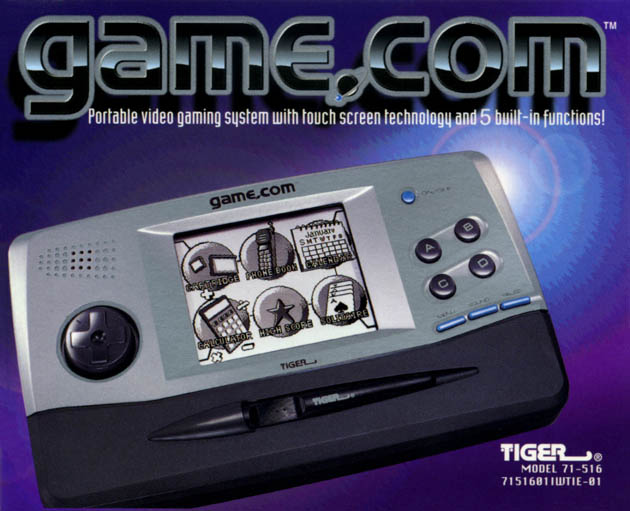A Boy and His Game.com: How One of Gaming’s Biggest Busts Ignited a Lifelong Passion
I often forget that Tiger’s Game.com handheld system was actually the first game system I ever owned.
Released in late 1997 by Tiger Electronics (best known at the time for their cheap standalone LCD games), the Game.com was designed as a Game Boy alternative for older gamers. It sounded amazing on paper: a fully-functional touchscreen, Internet connectivity, and ports of awesome games like Resident Evil 2 and Duke Nukem 3D. I’d played around with my friend’s Game Boys and thought they were pretty cool, but this sounded like the real deal. A real system for real gamers.
Young and completely naive, I was suckered in by Tiger’s truly bizarre marketing campaign and begged my parents to procure one in order to place it under the tree in time for Christmas.
It was that Christmas Eve when I learned the difference between perception and reality. What soared in theory floundered in practicality, and I was quickly underwhelmed by this new hardware I’d waited so long for.
In order to connect the bulky hunk of plastic to the Internet, one needed to purchase a Game.com-branded modem, an Internet cartridge, and a subscription to Tiger’s proprietary ISP. Once the hardware was in place and the bills were paid, actually getting it to connect was an exercise in total frustration, and those efforts were rewarded only with rudimentary text browsing and an email system that didn’t really work.
As for in-game features, all the Internet connectivity did was allow players to share high scores. No online play, whatsoever. Given the already minuscule user base, you can pretty much imagine how indisputably worthless the feature was.
But how about the games?
In the weeks leading up to that fateful Christmas, I imagined staying up all night with Duke Nukem 3D, blasting alien baddies and tipping strippers for quick peeps of all the pixelated boobies my prepubescent brain could handle. However, the experience was more like booting up the game on a long-outdated PC, turning the brightness all the way down, walking twenty yards away and attempting to play the game while severely intoxicated and wearing sunglasses.
The system’s low-res screen could not keep up with the onscreen action, even despite modest frame rates, which turned each game into a blurry mess of nondescript tedium. Awesome games like Fighters Megamix, Sonic Jam, and Mortal Kombat Trilogy were rendered completely unplayable when displayed on the Game.com’s tapestry of failure that was its monochrome display. How the system ever got past it’s initial testing phases, I’ll never know. Any gamer worth his or her salt at the time quickly dismissed this miserable unit and stuck to their trusty Game Boy.
There were, however, some really cool things about the Game.com. I don’t believe that the system’s failure was due to a lack of effort, but rather a lack of available technology to effectively implement such ambitious concepts.
Think about it: a touchscreen, internet connectivity, PDA-esque features and applications; the Game.com really was a precursor to immensely successful Nintendo DS, released seven years later. As simple and as unnecessary as it seems, the Game.com’s utilization of two separate cartridge slots was actually pretty convenient for the gamer on the go. And who can argue with a built-in game of Solitaire?
There was really only one game worth owning for the system, which, ironically, was actually a collection of really old games. Because of Williams Arcade Classics, my decision to ask for a Game.com was not completely in vain.
The game came loaded with five arcade classics: Defender, Defender II, Joust, Robotron: 2084, and Sinistar. Since it was the only game I owned that I could actually play without wanting to punt the system as far as I could, I spent countless hours trying to top my high scores in each game. To this day, I would rank Defender and Robotron: 2084 as two of my all-time favorites.
Thus, my love for retro gaming was born, and I may be the only person on the planet that can attribute their undying love for gaming to the Game.com.
The lesson I learned from this failed handheld was that it isn’t the implementation of the newest technology that makes a game great. Truly great games are more than just that; they are inventive ideas and inspiring concepts that translate to pure fun no matter what system they’re played on or which decade they’re developed in. Great games transcend their technology and appeal to us in ways that are beyond explanation.
Why was I so content to blast the same evil robots over and over to infinity when I could have easily traded it for something better? Probably the same reason I sit here a quarter-century into my life writing so passionately about my my hobby and pursuing what most of my peers would dismiss as a childish endeavor.
This is what I love, and there’s no way I’ll ever stop doing it. I’ll have plenty of time to grow up when I’m dead.



